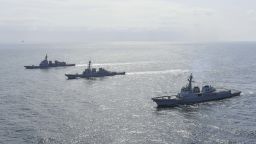UPDATE: The US Air Force has just activated the 431st Expeditionary Reconnaissance Squadron at Kunsan Air Base in South Korea, marking a significant escalation in military readiness amid rising tensions in the region. This historic move, announced on Monday, will establish a permanent presence of MQ-9 Reaper drones in East Asia, enhancing the US military’s capabilities to monitor threats from North Korea and beyond.
This activation follows recent military displays from North Korea, where leader Kim Jong Un appeared alongside China’s leader Xi Jinping during a large military parade. The Reaper drones, with a remarkable range of over 1,600 miles (2,575 kilometers), will significantly bolster US surveillance and reconnaissance operations over strategic areas, including the East China Sea and Taiwan.
“MQ-9 operations will support US-Korean priorities in intelligence, surveillance, and reconnaissance across the Indo-Pacific theater,” an official Air Force statement emphasized. The 431st Squadron has a storied history dating back to 1943 when it was first activated during World War II, showcasing the US commitment to maintaining security and stability in the region.
The Reapers are unmanned aircraft capable of carrying out a variety of combat missions, equipped with advanced surveillance technology and weaponry, including Hellfire missiles and laser-guided bombs. This upgraded capability is critical as the US military continues to reposition assets closer to North Korea; earlier this year, F-16 fighter jets were moved to form a “super squadron” at Osan Air Base, just over 80 miles away from Kunsan.
The permanent deployment of Reaper drones signifies Washington’s unwavering support for South Korea and its strategic allies in the Pacific. “Deploying the MQ-9 brings a powerful capability to the region,” stated Lt. Col. Douglas Slater, who will command the squadron. “We’re here to support the mission, deepen cooperation, and demonstrate our shared commitment.”
As military forces continue to adapt to changing global dynamics, this move is seen as essential for enhancing regional security. The US Air Force has not disclosed the exact number of Reaper drones being stationed at Kunsan, but an earlier fact sheet noted there are approximately 50 in the inventory of US Special Operations Command.
This development comes at a time when apprehensions about US commitments in the Indo-Pacific are rising. The Air Force’s strategy aims to reinforce its presence and ensure readiness against potential threats from adversarial nations.
As the situation evolves, observers are keenly watching how this permanent deployment will affect the broader security landscape in East Asia. The implications for US-Korean relations and regional alliances are significant, making this a pivotal moment for military strategy in the Indo-Pacific theater.
Stay tuned for updates as this story develops.
